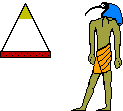| Measurements of the Great Pyramid |  |
| Measurements of the Great Pyramid |  |
The Great Pyramid of Giza was not called the First Wonder of the World for nothing: for over 4,000 years it was the tallest monument ever built and was equalled only in the late 16th century by the highest cathedrals. To this day it is still the largest stone monument in the world. It has been estimated that approximately 2,300,000 blocks had been used to build the great pyramid, each averaging 2.5 tons, making a total mass of 5.75 million tons. Most of the stone is limestone quarried locally, but granite blocks from Aswan were also used for the King's chamber: the 5.5 meter long granite beams forming its ceiling weigh between 25 and 40 tons each. Nowadays, the white Turah limestone casing is missing as well as the enclosure wall (which was over 8 meter high).
All measurements are in cubits, with the equivalence in meters between brackets (altitude means height above or depth below surface).
Click a part of the Great Pyramid
|
 |
|

|
|
|
|
 |
|

|